Peace and Nonviolence

I woke up this morning, like everyone else, to the news of a shootout with one suspect in the Boston Marathon bombing and the ongoing manhunt for a second brother. Like many others, I’ve heard lots of misinformation over the past few days about whether officials did or didn’t have a suspect, whether they did or didn’t have them in custody, and so on.
“I heard someone dropped a bomb on Boston,” said Mattias, my 9-year-old son, over breakfast while I scrolled through the breaking news reports.
“Not exactly,” I said. “It was two guys. Two brothers who came from [another country] to go to college at MIT.” They put homemade bombs in and around trashcans by the finish line of the marathon.”
“Why?” he asked.
“I really don’t know.”
“Maybe they were angry about something, and they didn’t know how to talk about their feelings.”
“Maybe so,” I nodded.
“Did they hurt people?”

When the really hard stuff happens, when we witness the true face of evil, Americans have a predictable habit. Even as cameras feed the latest bubble-shattering violence into our family rooms, we start looking for someone or something — anything — other than the actual perpetrators to stone. We panic for a scapegoat.
We hunt tirelessly for the person (a parent, an educator, a cop) who didn't catch the warning signs, who failed to read a memo — anyone on whose shoulders we can cast our collective fear — then rush as many measures into place as possible, no matter the cost in treasure or freedoms, to regain an illusion of safety and impenetrability.
One iteration of that really hard stuff happened at Sandy Hook. The backstory is eerily familiar. A young man, left to stew in our culture's juices, fleshes out the nightmare in his broken soul, and deals out tragedy in living color as if the holy innocents of Newtown were mere pixels on a screen, points in a twisted "shooter." Now, just four months later, it's a swept-away moment of terror and sadness that everyone just wants to forget because it's unthinkable to think on it any longer.
Virginia Tech, Aurora, and Newtown each stopped the nation in its tracks but we eventually moved on, and before anyone might guess, well over 3,000 more have died by gun violence in America since December.
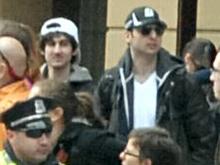
Boston residents are waking up this morning to a virtual shutdown of many parts of the city after a contfrontation that left one of the marathon suspects dead, according to reports. An M.I.T. police officer was also killed. From NBC News:
Law enforcement officials said the tumult began just before 11 p.m., when the suspects approached a police officer from the Massachusetts Institute of Technology and shot him in the head.
The two then stole the officer’s cruiser, robbed a nearby 7-Eleven, carjacked a Mercedes SUV and briefly kidnapped the driver, the sources said. The suspects threw explosives out the window during the chase that followed, they said. A Boston transit police officer was shot and wounded, authorities said.
The dead suspect — the man in the black hat from the FBI photos — had an improvised explosive device strapped to his chest, law enforcement officials said.
The two suspects have been identified as brothers — the one on the run identified as 19-year-old Dzhokhar Tsarnaev.
This story is developing.
Visit NBCNews.com for breaking news, world news, and news about the economy

The month-long break in drone strikes appears to have ended.
On Wednesday, a strike on a training camp in Pakistan killed at least five people. According to Al Jazeera:
“A US drone has fired two missiles into a Taliban training camp in Pakistan, destroying the compound and killing at least five people, local officials have said.“Wednesday's strike took place in the Baber Ghar area of the South Waziristan tribal district on the Afghan border, a stronghold of Pakistani Taliban leader Hakimullah Mehsud where the faction runs several camps.”
Also on Wednesday, two separate strikes in Yemen killed five. The Associated Press reported:
“Two U.S. drone strikes Wednesday killed at least five suspected al-Qaida militants and destroyed the house of one of them in a mountainous area south of the capital, Sanaa, a Yemeni security official and witnesses said.
“The four were killed in the first strike while riding a vehicle in the desert area of Oussab al-Ali, about 140 kilometers (90 miles) south of Sanaa, the official said. The second strike killed a fifth suspected jihadi, Hamed Radman. A drone bombed his house, the official said.”
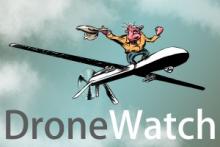
Ten major human rights and civil rights organizations have sent a statement to President Obama expressing their “shared concerns” about the U.S. targeted killing program using drones. The signatories included the American Civil Liberties Union, Amnesty International, the Center for Constitutional Rights, Human Rights Watch, and others.
The statement begins by summarizing the organizations’ concerns, and then elaborates on each point.
“The undersigned human rights and civil rights groups urge the United States to take essential steps to ensure meaningful transparency and legal compliance with regard to U.S. targeted killing policies and practices, particularly those outside the internationally-recognized armed conflict in Afghanistan. In particular, we call on the administration to: publicly disclose key targeted killing standards and criteria; ensure that U.S. lethal force operations abroad comply with international law; enable meaningful congressional oversight and judicial review; and ensure effective investigations, tracking and response to civilian harm."

The Boston Marathon bombing is so shocking because it was obviously done by someone(s) who wanted to prove something not to themselves, but to others. Could they display to the world his repressed rage enough? Could they divert attention to their cause enough? Could they maim and kill the innocent for some misguided agenda enough? That is what makes this act of terrorism so terrifying: a sick person or people trying to prove something to others by targeting those who are simply proving something to themselves, or trying to do something for others. It is jarring.
Ninety minutes before the bombs detonated, I was concluding a presentation on Jesus’ parable of the Good Samaritan. That recent immersion into Luke’s narrative shaped my video viewing of the bombing’s aftermath. The one who “fell into the hands of robbers” was everywhere. The assaulted and bloodied were scattered by the side of the road, in this case, Boylston Street. Instead of people passing by on the other side, however, it was quite the opposite. Spectators and emergency medical personnel waded into the grisly scene and treated the wounded with exquisite care.

A fertilizer plant exploded Wednesday evening, killing at least five and injuring more than 100, according to CNN. From the report:
"Nothing at this point indicates we have had criminal activity, but we are not ruling that out," said Sgt. William Patrick Swanton of the nearby Waco Police Department.
A more immediate question is how high the death toll will rise.
It could be between five and 15, Swanton said. Dr. George Smith, the city's emergency management system director, said it could spike to 60 or 70.
"We have two EMS personnel that are dead for sure, and there may be three firefighters that are dead," Smith said.
The U.S. Senate has just failed to get 60 votes on a bipartisan proposal to expand gun sale background checks. Politico reports:
“The vote was 54-46, with only four Republicans crossing the aisle and voting with the Democrats in favor of the bipartisan proposal by Sens. Joe Manchin (D-W.Va.) and Pat Toomey (R-Pa.). Sixty votes were needed.”
Four months after the Newtown massacre, a compromise measure that would have banned no guns, no magazines, is apparently still too strong. And what is especially outrageous is the continued abuse of the filibuster, requiring 60 votes for anything to pass the Senate. Is there any other legislative body in the world where a proposal can pass by 8 votes and lose?
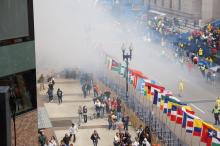
What do you say in the face of evil?
The stories from Monday’s attacks at the Boston Marathon are heartbreaking, gut-wrenching. One in particular stands out to me. A woman was waiting for her husband to cross the finish line when the bombs exploded. For three hours she searched frantically for him, not knowing if he was alive or dead, not knowing if he was frantic and looking for her. Her voice cracked and tears flowed with the raw memory as she told of the moment when she and her husband embraced.
Moments like this, even when they end happily, remind us of our vulnerability. As hard as we try to protect ourselves with heightened security measures, we know that complete invulnerability is impossible. I am vulnerable. My wife is vulnerable. My children are vulnerable. We cannot escape it.
In the face of gun violence and bombings, gender violence and rape, we would be irresponsible not to ask big questions about evil and human vulnerability.
A few hours after the bombing, President Barack Obama addressed our natural desire to carry out justice after these events.
[M]ake no mistake; we will get to the bottom of this. We will find out who did this, we will find out why they did this. Any responsible individuals, any responsible groups, will feel the full weight of justice.
Like the president, I want to take action against evil and I want to know I am secure. I hate admitting that I’m vulnerable. But the president’s words didn’t reassure me. They made me feel more vulnerable because the phrase “full weight of justice” is always a veiled call to violence.
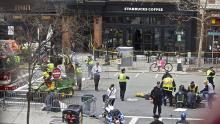
Resurrection is the theme of the 50 days of Eastertide. Yet, for decades, the month of April has been filled with particularly horrific deaths:
- The assassination of Martin Luther King, Jr. (April 4, 1968)
- The murder of 13 persons at the American Civic Association Immigration Center in Binghamton, N.Y. (April 3, 2009)
- The shooting death of 32 students at Virginia Tech. (April 16, 2007)
- The end of the Waco siege and the death of 82 members of the Branch Davidians. (April 19, 1993)
- The bombing of the Alfred P. Murrah Federal Building in Oklahoma City that killed one hundred sixty-eight children and adults. (April 19, 1995)
- The Columbine High School shooting resulting in deaths of 15 persons (April 20, 1999), a shooting that has been echoed in 31 schools since, most recently in Sandy Hook Elementary School of Newtown, Conn.
In 2013, April continues its trend. On Monday, April 15, someone decided to plant bombs along the route of the Boston Marathon. The explosions killed at least three people and wounded more than 100. Among the dead is 8-year-old Martin Richard.
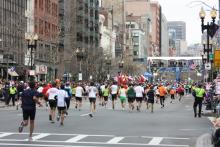
“How do you defend against terrorists?” asked a colleague, as we processed news reports of two bomb explosions near the finish line of the Boston Marathon.
The answer, truth be told, is you probably don’t defend against terrorism. Like a deadbolt on a residential door, you can create deterrents that slow the bad guys down. But a determined thief will only be delayed, not prevented.
Although it isn’t yet known whether these bombs in Boston were a terrorist attack, questions like my colleague’s arise because we live in such an open and “target-rich” society.
Guns are dangerous idols. While mass shootings are happening at an alarming rate and an epidemic of gun violence plagues our nation’s cities, our society’s fanatical devotion to weapons prevents us from enacting solutions to curb the violence. The cost of worshipping these false idols continues to rise, as firearms kill more than 80 people a day.
Since the Dec. 14 shooting in Newton, Conn., nearly 3,500 people have died because of a gun. Some of them were suicides. Some were gang-related gun deaths. Many use these facts to insinuate that the deaths somehow aren't equally tragic. But as Christians we know that all of them were children of God created in the Divine image.
While the idolatry rages on, prophets are beginning to speak out.

On Sunday evening, the first U.S. drone attack in nearly a month killed at least four people in Pakistan. The attack took place in Datta Khel town, 22 miles west of Miranshah, the main town in the North Waziristan region. According to Agence France-Presse:
Six US drones flew over the area when one of them fired two missiles at a compound in the Manzarkhel area of the town. "The drones kept hovering at the compound for a while and then one drone fired two missiles at the time of sunset," a local security official said. "At least four militants were killed in the strike," said the official.
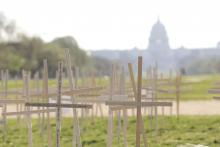
Last week, the Senate began a floor debate on gun control that brought to mind an earlier “floor debate” several months ago in Chaska, Minn.
Ever since our Community Dialogue on “Gun Violence in America,” I’ve searched for answers to what happened.
A crowd of 138 people came out on a Tuesday night to chime in following the tragedy at Sandy Hook in Newtown, Conn.
As the night wore on, it became clear that there would be no real dialogue, no moderated discussion. No give-and-take. A series of monologues, without interruption and with a time limit, was the best we could expect.
Fear, anger, hostility, and suspicion were in the room. The room was hot.
The months following have been a personal search for understanding of what happened that night, and how we in America move forward together on such a divisive issue.
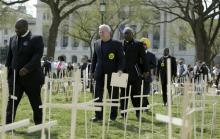
Clergy from California to Connecticut created a makeshift graveyard symbolizing victims of gun violence on the National Mall on Thursday as they exhorted Congress to pass legislation to limit access to firearms.
Standing in front of 3,300 grave markers — representing the number of people who have died in gun violence since December’s massacre in Newtown, Conn. — more than 25 ministers, rabbis and other religious leaders decried as “idolatrous” a society that values guns more than human life.
“We don’t have a Second Amendment issue,” said the Rev. Matt Crebbin of Newtown Congregational Church. “We have a Second Commandment crisis.
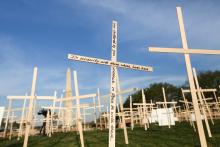
Today, on the National Mall, I stood with fellow faith leaders, including clergy from Newtown, to remember lives lost at Sandy Hook elementary school and the 3,364 gun deaths that have happened since.
We stood in front of a field of crosses, Stars of David, and other grave markers, and it broke my heart to think that each one stood for a life ended too soon. It doesn’t have to be this way. Commonsense steps to reduce gun violence are within our reach. Just today the Senate voted to begin the debate. But there is much work to do. Lawmakers need to hear from you.
This is one of the clearest examples of a stark democratic choice: the old politics of guns or the morality of the common good. The clergy are here today for the common good.

As the Senate takes up a heated debate over gun control and background checks, Catholic bishops have used the months since the Newtown school massacre to push gun control in email blasts and Senate Judiciary Committee testimony. But among the Catholic faithful, not everyone supports gun control measures.
Call them the NRA Catholics.
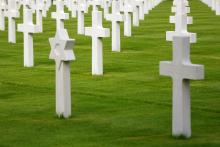
For many pastors of urban congregations, “stepping up” to end gun violence stems from a very personal place — as they have been forced to bury their own neighbors and church members. According to Samuel Rodriguez, gun violence – especially in urban areas – deeply affects interfaith leaders there, who are declaring violence-free zones and taking action.
Faith-based leaders in Philadelphia and Chicago have rallied to fight gun violence. Heeding God’s Call, based in Philadelphia, holds prayer vigils at the locations of gun homicides as well as organizes gun-store campaigns that ask gun store owners to sign a code of conduct.
In Chicago, All Saints Episcopal Church organized CROSSwalk, a walk through downtown Chicago, which drew a few thousand people the past two years. Violence on Chicago streets has killed more than 800 young people in the last six years.
Nuenke addressed breaking the chain of violence and pain that we see in every community. He quoted 2 Corinthians 1:3-4 and Isaiah 61 as examples of God’s compassion and its life-changing, healing power.
“What would happen if the body of Christ more fully was involved in living out Christ’s compassion in a broken world?” Nuenke asked. “Sometimes people who are hurt or experience violence end up hurting other people. The care and compassion they might receive from the Lord Jesus will impact them more in 20-30 years than anything else.”

After years of secrecy, the leaks of classified information on the drone killing program in Pakistan have turned into a torrent. Today, it was the McClatchy Newspapers, running two stories by national security and intelligence reporter Jonathan S. Landay.
The first examines in depth intelligence reports that covered most of the drone strikes in 2006-2008 and 2010-2011. Reviewing the killings covered in these reports, Landay concludes that:
“Contrary to assurances it has deployed U.S. drones only against known senior leaders of al Qaida and allied groups, the Obama administration has targeted and killed hundreds of suspected lower-level Afghan, Pakistani and unidentified “other” militants in scores of strikes in Pakistan’s rugged tribal area, classified U.S. intelligence reports show.”
The second, apparently using some of the same reports, reveals the history and extent of cooperation between the CIA and Pakistani intelligence. While Pakistan was aiding the U.S against al Qaida, CIA drones were aiding the Pakistani military against the Taliban.
“Even as its civilian leaders publicly decried U.S. drone attacks as breaches of sovereignty and international law, Pakistan’s premier intelligence agency secretly worked for years with the CIA on strikes that killed Pakistani insurgent leaders and scores of suspected lower-level fighters, according to classified U.S. intelligence reports. Dozens of civilians also reportedly died in the strikes in the semi-autonomous tribal region of Pakistan bordering Afghanistan that is a stronghold of al Qaida, Afghan militants, other foreign jihadists and a tangle of violent Pakistani Islamist groups.”
Both stories are long, both are well worth reading. Taken together, they reveal more secret details of the drone killing program.
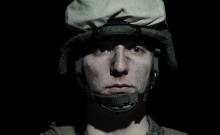
My Uncle Norman fought in Europe during World War II. An artillery observer, he didn’t return with many “heroic” stories to tell. When I was little, he would roll out some souvenirs from the war, and I’d be impressed: German military dress knives and lovely table linens. I don’t recall all of the stories or how these things became his, but I’m pleased to report the table linens were a gift. His war experience was hardly glamorous.
Uncle Norman did tell of one harrowing experience. He and his partner were identified by German artillery, and they experienced exactly the treatment they dished out. Out in front of their own unit, as they always were, they heard a shot go just overhead and explode behind them. Then one fell just short. Placing a shell a bit to the left and one to the right, the Germans had them zeroed in. Uncle Norman’s friend panicked, frozen, stuck to the ground. And in the last minute – as he remembered it – my uncle tackled his partner and carried him to safety. Pretty dramatic stuff for a kid to hear.
When Uncle Norman was much older, he came close to death after gall bladder surgery. That night he experienced profound nightmares, the Lady Macbeth experience of bloody hands he could not cleanse. The next day, he told me a very different story than the ones I’d heard before. I believe I was the first to hear of the time when he called in the coordinates for an intersection across which a significant body of Germans was crossing. For 30 minutes, he said, he watched the effects of the barrage he had targeted. And now, 40 years later, his hands wouldn’t come clean.